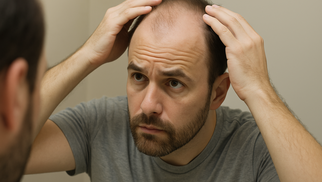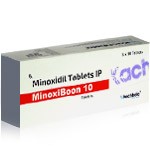From Hairline Changes to Treatment: What You Need to Know


A receding hairline is one of the most common early signals that your hair is changing. For some, it’s a normal shift in hairline shape that comes with age. For others, it marks the beginning of male-pattern or female-pattern hair loss. Understanding what’s happening on your scalp — why the temples look thinner, why the front seems higher than it used to be, and what you can realistically do about it — can turn a worrying discovery into a plan.
What a Receding Hairline Actually Is
Your hairline is the border where facial skin transitions into scalp hair. In childhood and early adolescence, that line is typically low and rounded. As hormones settle in late teens and early twenties, many people experience a “mature” hairline: the corners at the temples creep back by a centimeter or two and the shape becomes more M-like than U-like. That normal maturation is not the same as balding.
A receding hairline, by contrast, describes progressive thinning and backward movement of the frontal hair border beyond what’s expected for maturation. The most visible points are the bilateral temples, which can hollow out, and the mid-frontal tuft, which can narrow. On the classic Norwood scale used for male-pattern hair loss, the earliest changes are at the temples; later, the recession can meet a thinning crown.
In women, the frontal hairline often stays put while the density behind it decreases (a diffuse widening of the part). But some women — especially those with a strong family history — do notice temple recession that resembles the male pattern.
Why It Happens: Biology and Triggers
The most common driver is androgenetic alopecia (AGA), a hereditary condition caused by follicles’ sensitivity to the hormone dihydrotestosterone (DHT). Over time, susceptible follicles miniaturize: the growth phase (anagen) shortens, hairs grow back thinner, and eventually some follicles stop producing visible hair. Genetics set the blueprint, but other factors can influence the tempo:
- Hormonal context: puberty, postpartum shifts, perimenopause/menopause, and endocrine issues can unmask a predisposition.
- Health stressors: nutritional deficiencies (iron, vitamin D), significant weight loss, high fevers, major illness, and chronic stress can push hairs into shedding (telogen effluvium) and reveal an underlying pattern.
- Hair practices: tight hairstyles and frequent traction at the temples, chemical relaxers, hot tools, and harsh styling can worsen breakage and loss at a vulnerable hairline.
- Scalp environment: seborrheic dermatitis and chronic inflammation may aggravate miniaturization for some people.
None of these causes invalidate genetics; rather, they push on an already open door.
“Why Am I 18 With a Receding Hairline?”
Two realities can coexist at 18. First, a maturing hairline is completely normal between 16 and 25. Photos from ages 12 to 15 can be misleading — faces elongate, foreheads look taller, and a centimeter of temple movement can feel dramatic. Second, early-onset AGA does occur. Strong family history, noticeable miniaturization on close inspection (thinner, shorter hairs mixed with thicker ones), accelerated temple hollowing, and thinning at the crown alongside the front all point toward true pattern loss rather than simple maturation.
If you’re 18 and worried, the practical steps are: document your hairline with consistent photos in good light; examine for miniaturized hairs; review family history; and consider a professional assessment. Early recognition matters because early interventions stabilize best.
“Am I Balding or Is It Just My Hairline?”
Ask yourself — and your mirror in bright, even light — these questions:
- Is density behind the frontline also decreasing, or is it only the edge? Balding often shows a gradient of density loss, not just a sharp line shift.
- Are there many miniaturized (finer, shorter) hairs at the temples and along the mid-frontal scalp? That mosaic of thin and thick hairs indicates active miniaturization.
- Has the crown changed? AGA commonly involves both crown and front over time.
- Is the change continuous over 6–12 months? A maturing hairline tends to stabilize; pattern loss creeps.
Dermatologists use dermoscopy to count and measure hairs per follicular unit and see miniaturization you can’t easily detect at home. If you’re unsure, that magnified exam provides clarity quickly.
Can a Receding Hairline Grow Back?
It depends on what’s driving it and how long it’s been happening. When follicles are miniaturized but still alive, they can often be coaxed into producing thicker hairs again. When follicles have become dormant (fibrosed), regrowth is unlikely and the goal becomes preserving what remains and redistributing hair surgically if desired.
- Maturing hairline: not a disease and not typically “reversible,” though the appearance can be softened with styling, hair fibers, and, for some, medical therapy that thickens nearby hairs.
- Early AGA: stabilization is highly achievable, and partial regrowth is common with the right regimen.
- Long-standing recession: medical therapy may thicken surrounding hairs and slightly “fill in” the border, but dramatic advances at a slick, shiny temple are less likely without transplantation.
Expectations matter. Most medical treatments take 3–6 months to show stabilization and 6–12 months for visible thickening. Hair grows slowly, about a centimeter per month, and improvements are incremental rather than sudden.
Building a Thoughtful Management Plan
Because pattern hair loss is a chronic condition, successful plans focus on three pillars: halting miniaturization, supporting healthy growth, and camouflaging aesthetically while you wait for biology to catch up with desire.
- Medical therapy to slow loss: Agents that counter DHT (like finasteride for men; certain off-label options for women under medical supervision) reduce the hormonal signal that drives miniaturization. Topical vasodilators/growth promoters like minoxidil directly lengthen anagen, regardless of DHT. The combination is often more effective than either alone.
- Supportive measures: Correcting iron deficiency or low vitamin D when present; treating scalp inflammation; avoiding traction; optimizing gentle hair care; managing stress and sleep. These don’t reverse AGA alone, but they remove brakes on growth.
- Procedural options: Low-level laser therapy may stimulate mitochondria in follicle cells; microneedling creates micro-injuries that can amplify topical responses when done correctly; platelet-rich plasma (PRP) injections aim to deliver growth factors; and hair transplant surgery redistributes robust hairs from the back/sides to the front when medical therapy alone can’t meet goals. Even with surgery, ongoing medical therapy protects non-transplanted hairs.
The Role of Minoxiboon
Minoxiboon is a topical minoxidil-based treatment (available in liquid or foam formats at strengths typically used for men and women) designed to reactivate miniaturized follicles. Minoxidil’s mechanism isn’t purely about blood flow; more importantly, it pushes follicles into — and keeps them in — the growth phase longer while enlarging the hair shaft produced. That’s exactly what a thinning hairline needs: more hairs spending more time growing, each emerging thicker than before.
How Minoxiboon fits into a plan:
- Where it helps most: Along the thinning frontal zone and temples where vellus-like miniaturized hairs are still visible. If the skin is completely slick and shiny with no tiny hairs, expectations should be modest there.
- How to use: Consistency matters more than timing. Most regimens call for once- or twice-daily application to a dry scalp, with clean fingertips or a precision applicator to trace the hairline and temple recessions. Allow it to dry fully before styling products; avoid washing it off for at least four hours.
- What to expect: Many users notice increased shedding in the first 4–8 weeks. That’s usually a sign that resting hairs are being cycled out to make room for longer anagen growth. Visible stabilization often emerges by month three; thickening is usually assessed at six months and continues to improve through month twelve. Photograph your hairline monthly under the same lighting and angle — tiny wins accumulate.
- Combining Minoxiboon: On its own, it can produce meaningful thickening. Paired with an anti-androgen strategy (for men, an approved DHT-lowering medication; for women, physician-guided options when appropriate), results tend to be stronger and more durable. Microneedling (at-home rollers used cautiously or in-office devices) can enhance penetration — ideally supervised to avoid over-irritation at the delicate temples.
- Side effects and tips: Mild scalp irritation or dryness can occur, especially with liquid solutions that contain alcohol/propylene glycol; foam formats are often gentler. If irritation appears, reducing frequency temporarily, applying a light, non-occlusive moisturizer to the scalp after Minoxiboon dries, or switching formulations may help. Because minoxidil stimulates hair wherever it contacts, carefully wipe away drips to avoid unwanted facial hair.
Minoxiboon does not change your hormonal landscape, so it’s appropriate for a wide range of people and can be continued long-term. The catch: its benefits persist only while you use it. Stop, and miniaturization gradually resumes. Think of it like brushing your teeth — part of routine maintenance, not a one-and-done fix.
Special Considerations for Different Ages and Situations
Late teens and early twenties: If your hairline is shifting and you’re unsettled by it, baseline photographs, a scalp exam, and an early trial of Minoxiboon can be reasonable. If there’s a strong family history of early AGA, discussing DHT-targeted therapy with a clinician is sensible for men. For young women with temple thinning, lab work to rule out iron deficiency and thyroid issues is a good first step, alongside topical therapy.
During pregnancy and breastfeeding: Many medical hair-loss treatments are paused. Some people experience fuller hair during pregnancy and shedding postpartum. If your hairline is a concern in this window, gentle care, styling strategies to soften the temples, and discussions with your obstetric provider about what is safe are key. Resume longer-term treatments when medically appropriate.
Ethnic and hair-type differences: Curl patterns and density mask or magnify temple changes differently. Traction alopecia from tight protective styles often begins at the hairline; reducing tension early can prevent permanent loss. Minoxiboon can be helpful once traction is addressed, but changing styling habits is fundamental.
Making It Look Better While Biology Works
While you’re investing months into follicle health, you deserve to like your reflection now. A slightly shorter, textured cut can reduce contrast between the forehead and hair. Strategic layering around the front, matte styling products, and color techniques that de-emphasize scalp show-through can be transformative. Hair fibers bond to existing hairs and are especially effective at the front when applied lightly and locked with spray. If facial hair suits you, a well-kept beard can rebalance proportions visually.
When to See a Professional
Seek a dermatologist, trichologist, or hair-restoration specialist if you notice rapid change over a few months, patchy loss, scaling or inflammation, disproportionate shedding after illness, or if you’re simply unsure what you’re seeing. An accurate diagnosis prevents wasted time and helps you choose a plan with the highest chance of success. Bring your questions, your timeline, and your goals; bring photos too. It’s your hairline — your strategy should match your life.
Bottom Line
A receding hairline can signal anything from a normal maturing pattern to the earliest stage of genetic hair loss. The difference shows up in the details: miniaturized hairs, changing density behind the border, family history, and steady progression. Growth can return where follicles are still alive, and the earlier you act, the better your odds. Minoxiboon — a topical minoxidil preparation — sits at the center of many modern regimens because it lengthens growth cycles and thickens miniaturized hairs, particularly effective along thinning frontal zones and temples. Pairing it with supportive care, smart styling, and, when appropriate, additional medical or procedural therapies gives you both short-term confidence and long-term control.
Drug Description Sources: U.S. National Library of Medicine, Drugs.com, WebMD, Mayo Clinic, RxList.
Reviewed and Referenced By:
Dr. Alan J. Bauman, MD Board-certified hair restoration physician, founder of Bauman Medical Hair Transplant and Treatment Center. Recognized expert in hairline restoration and non-surgical therapies including minoxidil.
Dr. Robert M. Bernstein, MD, FAAD Clinical Professor of Dermatology at Columbia University, pioneer in hair transplant techniques. Widely published on male-pattern baldness and medical treatments for hairline recession.
Dr. Shilpi Khetarpal, MD Board-certified dermatologist at Cleveland Clinic, contributor to health publications. Provides expert reviews on hair loss causes in young adults and effectiveness of topical treatments like minoxidil.
Dr. Antonella Tosti, MD Professor of Dermatology at the University of Miami, world-renowned for research in hair and scalp disorders. Her clinical insights address diagnosis of receding hairlines and treatment response in women and men.
(Updated at Sep 30 / 2025)

